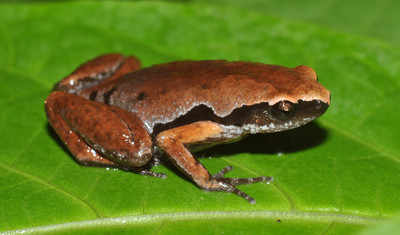- News
- Education News
- News
- Scientists discovers a beautiful new frog in Assam
Trending
This story is from June 11, 2019
Scientists discovers a beautiful new frog in Assam
A team of scientists from University of Delhi and Wildlife Institute of India, in collaboration with researchers from Indonesia and USA, have discovered a remarkably beautiful new frog belonging to the microhylid genus Micryletta from the Northeast of India.

NEW DELHI: A team of scientists from University of Delhi and Wildlife Institute of India, in collaboration with researchers from Indonesia and USA, have discovered a remarkably beautiful new frog belonging to the microhylid genus Micryletta from the Northeast of India.
Commonly known as paddy frogs, this is the first known species of this genus was originally described from the island of Sumatra in Indonesia.Currently, there are only four recognized species in this group.
The newly discovered Micryletta frog from Northeast India was confirmed as a new species by detailed comparison of both DNA and morphology with all previously known members across Southeast and East Asia.
What is surprising is that the new species is not found far from human habitations. “Our discovery shows that even fairly common frogs usually found closer to human habitations are still not documented properly. More extensive studies are required to scientifically identify and describe the North-eastern frogs which are already facing extinction threats from various human activities,” said Abhijit Das, from Wildlife Institute of India.
“The actual number of frog species in Northeast India is much higher than the current estimates. What remains is for us to carry out dedicated surveys in unexplored regions and undertake comprehensive studies using integrative taxonomy, just like the Western Ghats where the number of known amphibian species has nearly doubled within a short span of ten years, making it one of the leading biodiversity hotspots in the world with an unprecedented rate of new frog discoveries,” said professor S D Biju from DU.
The new species is named aishani, derived from the Sanskrit word ‘aishani’ or aiśānī (meaning north-east), referring to the Northeast regions of India where this frog was discovered. Micryletta aishani strikingly differs from other narrow-mouthed paddy frogs by characters such as reddish-brown coloration on back, prominent dark streaks and ash-grey mottling on the lateral sides, shape of the snout, and absence of web on its feet. The DNA analyses in the new study also indicate the presence of more undescribed species in this genus from Southeast Asian regions such as Laos, Thailand, and Vietnam.
The researchers discovered and described Micryletta aishani based on specimens collected from a degraded forest area in Cachar district of Assam. “The new species is likely to be more widely distributed in Northeast India, particularly the Indo-Burma biodiversity hotspot region that lies south of River Brahmaputra. Micryletta aishani is currently endemic to Northeast India but it could very well be present in the neighboring regions of Bangladesh and Myanmar,” said Sonali Garg, DU.
Commonly known as paddy frogs, this is the first known species of this genus was originally described from the island of Sumatra in Indonesia.Currently, there are only four recognized species in this group.
The newly discovered Micryletta frog from Northeast India was confirmed as a new species by detailed comparison of both DNA and morphology with all previously known members across Southeast and East Asia.
What is surprising is that the new species is not found far from human habitations. “Our discovery shows that even fairly common frogs usually found closer to human habitations are still not documented properly. More extensive studies are required to scientifically identify and describe the North-eastern frogs which are already facing extinction threats from various human activities,” said Abhijit Das, from Wildlife Institute of India.
The past decade has witnessed an exponential increase in the number of new amphibian species described from India, particularly the Western Ghats. However, the rate of discovery and description of novelties from Northeast India has been relatively slower.
“The actual number of frog species in Northeast India is much higher than the current estimates. What remains is for us to carry out dedicated surveys in unexplored regions and undertake comprehensive studies using integrative taxonomy, just like the Western Ghats where the number of known amphibian species has nearly doubled within a short span of ten years, making it one of the leading biodiversity hotspots in the world with an unprecedented rate of new frog discoveries,” said professor S D Biju from DU.
The new species is named aishani, derived from the Sanskrit word ‘aishani’ or aiśānī (meaning north-east), referring to the Northeast regions of India where this frog was discovered. Micryletta aishani strikingly differs from other narrow-mouthed paddy frogs by characters such as reddish-brown coloration on back, prominent dark streaks and ash-grey mottling on the lateral sides, shape of the snout, and absence of web on its feet. The DNA analyses in the new study also indicate the presence of more undescribed species in this genus from Southeast Asian regions such as Laos, Thailand, and Vietnam.
The researchers discovered and described Micryletta aishani based on specimens collected from a degraded forest area in Cachar district of Assam. “The new species is likely to be more widely distributed in Northeast India, particularly the Indo-Burma biodiversity hotspot region that lies south of River Brahmaputra. Micryletta aishani is currently endemic to Northeast India but it could very well be present in the neighboring regions of Bangladesh and Myanmar,” said Sonali Garg, DU.
End of Article
FOLLOW US ON SOCIAL MEDIA










